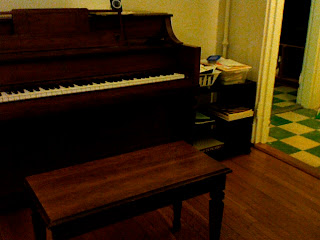The bus ride to New York, which normally takes four hours and change, takes seven with traffic. My friend A had booked dinner the week before and was afraid we might miss our reservation, but we finally arrive in Chinatown with time to spare. I change shirts on the subway (much to A’s disbelief) and my pants at a nearby Starbucks. We then meet up with K, A’s boyfriend, and head over to Chez Josephine, the first stop on our Restaurant Week splurge; it’s A and K’s belated birthday treat to me.
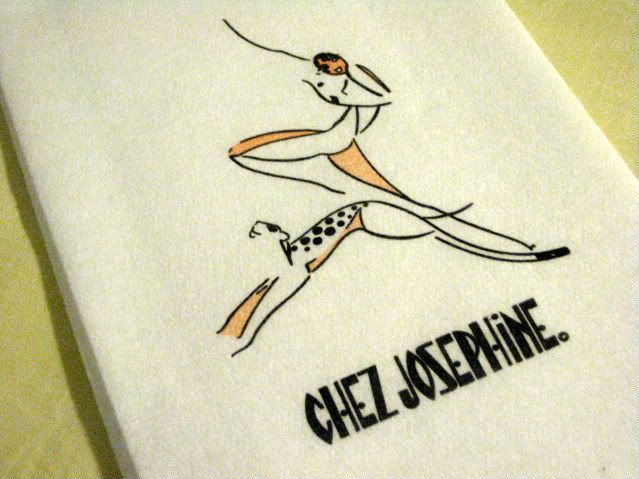 Chez Josephine is a swank looking bistro dedicated to the Americaine in Paris who became famous for her dancing career in the twenties and thirties. The first thing we hear upon entering is the pianist who’s actually quite good and has a voice perfect for crooning standards. Sadly, the entertainment impresses more than the food. We all order menu items prix fixe. While the beet salad is a delightful starter with a nice play of textures, my roast chicken is overcooked and my lemon crème brulée just par. Nonetheless, I enjoy the ambiance and whole experience and wish I hadn’t left my camera in the car. At night, the decor of turquoise walls and chandeliers in tangerine really jazzes up the space.
Chez Josephine is a swank looking bistro dedicated to the Americaine in Paris who became famous for her dancing career in the twenties and thirties. The first thing we hear upon entering is the pianist who’s actually quite good and has a voice perfect for crooning standards. Sadly, the entertainment impresses more than the food. We all order menu items prix fixe. While the beet salad is a delightful starter with a nice play of textures, my roast chicken is overcooked and my lemon crème brulée just par. Nonetheless, I enjoy the ambiance and whole experience and wish I hadn’t left my camera in the car. At night, the decor of turquoise walls and chandeliers in tangerine really jazzes up the space.
As a continuation of this French theme, we catch the matinée of Boeing Boeing the next day all thanks to A. It is this year’s Tony winner for Best Play Revival and deservedly so. The cast is amazing and the story happens to speak to my research concerning the emergence of aesthetic and political internationalism (because even on holiday, I’m thinking about school).
Boeing Boeing, by Marc Camoletti, takes off from the advent of passenger aircraft during the 1960s. In this period farce, faster engines have made it possible to boink multiple “air hostesses” from different airlines so long as their paths never cross. As Bernard (Bradley Whitford), the architect of this diplomatic venture, explains:
Pure mathematics, everything organized, regulated, and working to the precise second. The earth turns on its axis and my three fiancées wheel above the earth. One this way. One that. One towards the sun. One towards the moon. And eventually, they all come in home to me. No alarms. No surprises. It’s geometric my dear Robert, so exact as to be almost poetic. And here I sit in the middle the typical example of polygamous despotism.
The center of the universe is a beautiful standing set featuring seven doors (making for plenty of opportunities to hide and appear) and furnished with period pieces such as Barcelona chairs and a glass desk. Rose, lemon, and cerulean accents —they rhyme with the air hostess uniforms—recall the pastel realms of French New Wave filmmaker Jacques Demy (cf. Les Demoiselles de Rochefort), while the modernist counterpoint between squares and circles is a fitting correlate for the sexual antics on stage.
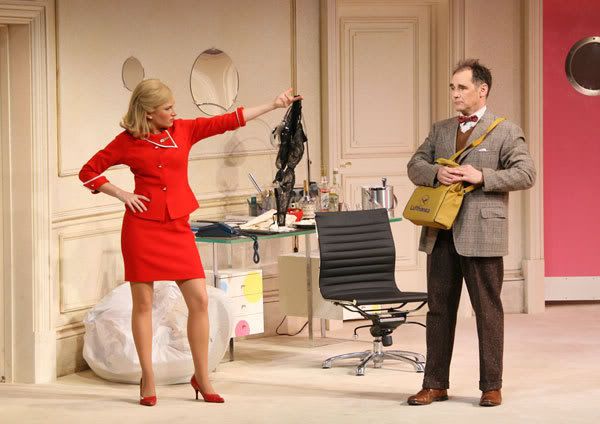 Everything runs like clockwork until the planes outrun Bernard’s timetables. We watch in anticipation of the inevitable collision as Bernard, Robert, and Berthe (the maid) struggle to keep the fiancées from finding out about each other. The three fiancées Gloria (Kathyrn Hahn), Gabriela (Gina Gershon), and Gretchen (Mary McCormack)—alliteration is insurance against memory lapse—are coruscating caricatures of Americans (worshippers of kink, ketchup, and money), Italians (the best-dressed sentimentalists), and Germans (hardcore taskmasters), respectively. And while their accents are stiltedly stereotypical, they execute them with so much élan and physicality that you are too busy laughing to care. The one actor who manages to pull off the foreign accent is Mark Rylance as Robert. The Brit, who won this years Tony for Best Actor, is hilariously on point as the bashful businessmen from Wisconsin turned horndog à la Bernard. Christine Baranski’s French is atrocious, but her Berthe scores points for the crabbiness befitting a soubrette.
Everything runs like clockwork until the planes outrun Bernard’s timetables. We watch in anticipation of the inevitable collision as Bernard, Robert, and Berthe (the maid) struggle to keep the fiancées from finding out about each other. The three fiancées Gloria (Kathyrn Hahn), Gabriela (Gina Gershon), and Gretchen (Mary McCormack)—alliteration is insurance against memory lapse—are coruscating caricatures of Americans (worshippers of kink, ketchup, and money), Italians (the best-dressed sentimentalists), and Germans (hardcore taskmasters), respectively. And while their accents are stiltedly stereotypical, they execute them with so much élan and physicality that you are too busy laughing to care. The one actor who manages to pull off the foreign accent is Mark Rylance as Robert. The Brit, who won this years Tony for Best Actor, is hilariously on point as the bashful businessmen from Wisconsin turned horndog à la Bernard. Christine Baranski’s French is atrocious, but her Berthe scores points for the crabbiness befitting a soubrette.
Though Boeing Boeing is very much a period piece (when was the last time you received a telegram?), the stunning cast and delicious plot makes for world class entertainment.
July 26th, 2008
Since passing the big 2 5, I find birthdays more depressing than ever. Getting older loses its appeal when you have no new milestones to celebrate and your special day arouses the same dread as a deadline: “This paper is due in three hours and I haven’t even started!” In college, we had finals, recitals, and even p.e. to boost our self-esteem. But in grad school, there’s what? Teaching evaluations? Awesome powers of interpretation? The only milestones in the academy are getting hired and getting published. That and the dissertation, and I ain’t quite there yet.
Today’s gloom was exacerbated by thunderstorms. This morning, I had to splash my way to the hospital. It’s been a month since I began taking this drug called isotretinoin to treat nodular acne. I’m happy with my chapped lips and inability to cry, though dread the more adverse side effects ranging from organ damage to suicidal depression. If that isn’t bad enough, treatment requires a pledge of abstinence for six months (the treatment period is five) since the drug causes serious birth defects in unborn children. A paper chad with the X’ed out icon of a pregnant woman stands between me and each of the tiny, orange pills; I’ve punched out 60 so far. Given the potency of the drug, I have to get a blood test every pill cycle just to make sure the drug isn’t messing up my system. Then I’m cleared for the next 30-day supply to be picked up the next day. Today was day thirty, my first blood test and my 26th birthday.
When I got home, it was still thundering outside, and I felt like reading some Beckett, who, I remembered, wrote a play for such occasions. Krapp’s Last Tape is a one-act about the tragedy of selfhood, but it is also a play about birthdays.
At the age of 69, Krapp remains single and pretty much feels like his name. To pass the time, he drinks a lot (backstage) and downs bananas (onstage) in a ritual suggestive of auto-fellatio. Since his twentieth birthday, he has kept an audio diary on a set of tape reels. Every birthday, he plays entries from past birthdays before recording his latest reflections on a fresh tape. You could say that Krapp was a podcasting pioneer.
His annual reports, however, bring little joy to the listener. He expresses little remorse for his mother’s death and recalls being accused of harassment after trying to flirt with a lady outside his mother’s room. He regrets calling off a love affair with a past flame. These events are never relayed in linear fashion. Longing, frustration, envy, make him rewind and fast-forward, stop, start, and linger on certain tapes. And it is through his attempts to connect with his past selves that we begin to understand his failure to connect with others. At one point, he stops the tape to look up the meaning of an unfamiliar word uttered by a Krapp forty years his junior:
[reading from a dictionary] State — or condition — of being — or remaining — a widow — or widower. [Looks up. Puzzled.] Being — or remaining? … [Pause. He peers again at dictionary. Reading.] “Deep weeds of viduity” … Also of an animal, especially a bird … the vidua or weaver-bird … Black plumage of male … [He looks up. With relish.] The vidua-bird!
Why does Krapp go from puzzled to delighted in the blink of a word? Is it that he’s tickled by the tritone of meanings here. While viduity denotes forlornness, its sound evokes a creative being (“weaver bird”), which appeals to the writer’s sagging ego (“plumage of male”). But I also hear the resonance of vidua and viduity with individual. Individuals are not in-divisible, as the etymology would have us believe. Rather, each person, like a tape reel in a box of many tape reels, remains vidual, alienated from his past selves.
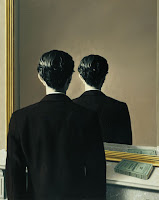 Krapp’s Last Tape is like the dramatic counterpart to Magritte’s La Reproduction Interdite (Not to be Reproduced, right), in which a man stares into a mirror and only sees the back of himself. So how does one escape the abyss? I suppose it requires a leap of sympathy, though that only leads to rejection in Krapp’s case, or else the willingness to make oneself vulnerable for the sake of making a connection. And yet, despite seeming to grasp the import of this passage, here I remain in my weeds of viduity….
Krapp’s Last Tape is like the dramatic counterpart to Magritte’s La Reproduction Interdite (Not to be Reproduced, right), in which a man stares into a mirror and only sees the back of himself. So how does one escape the abyss? I suppose it requires a leap of sympathy, though that only leads to rejection in Krapp’s case, or else the willingness to make oneself vulnerable for the sake of making a connection. And yet, despite seeming to grasp the import of this passage, here I remain in my weeds of viduity….
…until the next day, when my friend and I take the bus to New York and the real party begins. The moral of this story: like deadlines, birthdays are best honored one day late.
July 24th, 2008
A month has passed since my last post. I’ve been learning how to tinker with the blogger template but need to hone my Illustrator and Javascript skills before attempting any significant design upgrades.
I love learning foreign languages. In high school, I took four years of Spanish; in college, three semesters of German. When I got to grad school, I wanted to learn French but only had time to take a reading course. This summer, I’m attempting to teach myself Latin so I can fulfill my classical language degree requirement. Though I can speak, read, and write in Spanish, my German and French have suffered from underuse. Latin is more fresh in my mind. For whatever reason, I have an easier time learning and conjugating the verbs than I do declining the nouns, whose genders and cases always trip me up. All this, I hope, will change.
In my quest for language learning aids for the twenty-first century, I discovered a number of online resources entirely free of charge. I recommend them to anyone who wishes to learn a foreign language on his own time but doesn’t want to pay the big bucks for programs like Berlitz or Rosetta Stone. Here are some of my favorites finds for learning romance languages.
Modern European Languages
- Annenberg Media: In the 80s and 90s, Annenberg used to air a number of educational series for public television. Though I used to mock many of these shows for their out-of-date production values, I’ve changed my tune since reacquainting myself with their foreign language series, which you can watch in full on their website via videostream: French in Action (52 half-hour videos), Fokus Deutsch (48 quarter-hour videos), Destinos (52 half-hour videos), and Connect with English (ESL) (50 half-hour videos). At the moment, I’m watching French in Action, a production of Yale and Wellesley Colleges. Narrated entirely in French, the series follows the story of Mireille and Robert as collectively imagined by an enthusiastic French professor and his bright yet bored class of students. Comic notes of resistance are provided by the smart-mouthed Michael who, for instance, fights the professor to rename the heroine Ethel instead of Mireille.
- BBC Languages: More up-to-date than Annenberg is the BBC’s interactive video programs. In addition to the languages listed above, the BBC also caters to viewers interested in learning Greek, Italian, Portuguese, and Chinese. The site includes useful features such as diagnostic tests, video captioning, and interactive assignments, but the programs are far less immersive and ambitious than Annenberg’s.
- Online Dictionaries: While there are a number of foreign language dictionaries available online, not all of them have user forums where members, both newbies and experienced speakers, can discuss the living language. For students of German, there’s LEO, whose interface lets you look up words in English, French, Spanish, and Chinese for their German equivalents and vice versa. For non-Germanic romance languages (Spanish, French, Italian, Portuguese), there is wordreference.com.
Classical Languages
- Textkit: Greek and Latin Learning Tools: With seven cases, five species of declensions, and as many conjugation paradigms to memorize, it’s no wonder Latin has fallen out of favor. Despite the fact that you only need to learn a mere fourteen hundred words to become proficient, learning Latin, or any other languages with its case system in tact, can be an arduous process. Sites like Textkit, however, will help you earn your coveted laurels. On Textkit, you’ll find a number of downloadable resources including Latin and Greek grammars in the public domain as well as an answer key to the much touted Latin textbook, Wheelock’s Latin. I visit their discussion forum to ask questions regarding translation and get my homework checked by the friendly Latin aficionados.
- Perseus Digital Library: For advanced students, my friend Anne recommends Perseus, which hosts a wide selection of Latin and Greek texts. Clicking on any word in the etext will bring up a popup window displaying its grammatical profile (part of speech, number, gender, case, voice, etc.) as well as a link to a dictionary entry.
- Nuntii Latini: In its efforts to keep the language alive, the Finnish radio station YLE streams a five-minute news podcast in Latin every week.
All Languages (Building Vocabulary)
- Wordchamp.com: The best way to absorb vocabulary is to put it to use, but for those with difficulty finding a language buddy, there’s Wordchamp. With Wordchamp, you can create flashcards and synchronize them to any text you happen to be studying. The site has support for a remarkable number of world languages including Basque, Chinese, Uzbek, Yoruba, even Klingon. Whatever flashcards you make (or borrow from someone else’s stockpile) form the basis of a set of drills which test everything from definitions to comprehensive verb conjugation. Many of the words in Wordchamp’s database are accompanied by audio mp3s which means you can also practice pronunciation. The site even lets you download these files to upload to your Ipod. Complete conjugation charts are available for common verbs in many, but not all, languages. You can hook up with other members or tutors to form study groups (though the latter will cost you money). The most awesome feature of the site is the Webreader, which lets you to dock to a foreign language website (e.g. try a German or French newspaper), whereupon you can make instant flashcards from any unfamiliar words as well as access definitions if those words happen to be in Wordchamp’s database.
If you know of any other language learning sites, drop me a line.
June 26th, 2008
At that time all of us began to think
with our bare hands and even with blood all over
them, we knew vertical from horizontal, we never
smeared anything except to find out how it lived.
Fathers of Dada! You carried shining erector sets
In your rough bony pockets, you were generous
And they were lovely as chewing gum on flowers!
Thank You!
– Frank O’Hara
O’Hara was to the Cold War what Apollinaire was to the Great War—a poet and art critic, a charismatic champion of the contemporary avant-garde. As the assistant curator for the International Program of the Museum of Modern Art, O’Hara helped to prepare overseas exhibits of Abstract Expressionists such as Jackson Pollock and Willem de Kooning. These touring exhibits represented the joint efforts of both the art establishment and the state to pursue an anti-Communist program of containment by peaceful means of diplomacy. Like many intellectuals of the time, O’Hara professed a strong belief in the diplomatic potential of art to bridge gaps between foreign cultures, or in the case of the Soviet Union, to prevent rivalries from escalating. In his typically witty and conversational style, O’Hara salutes in the poem above not the soldiers who fought in war—O’Hara himself served as a sonar man—but the artists of the previous generation who fought against it.
May 26th, 2008
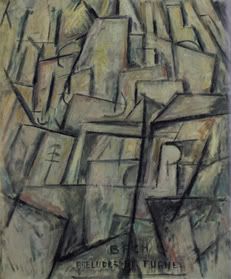
B. is for Bach—
and all his noble sons,
who wrote square music for nave
and for loft,
for arch and for aisle,
for all the lost, forsaken things
no other sound will save—
– Marsden Hartley
right: Musical Theme No. 2
(Bach Preludes et Fugues), 1912
Marsden Hartley is a name easily lost among the shuffle of American modernists. He belonged to the same illustrious circle as Georgia O’Keefe and Charles Demuth, but compromised his celebrity by unveiling a series of some fifty paintings whose seeming subject was the German military. On the eve of the Great War, the predilections of the “War Motif Series” and its homoerotic overtones were unsurprising cause for suspicion.
The most enterprising painter to emerge from Stieglitz’ stable at Gallery “291,” Hartley traveled to Paris in 1912 to keep abreast of the latest developments in modern painting. Music seemed to be on everyone’s mind. Picasso, for example, was incorporating the musical motifs of his native Spain into his cubist paintings and was soon to cultivate a friendship with Stravinsky. Kandinsky, whom Hartley followed to Berlin, likened the spiritual swirls of color on his musically-named canvases to Schoenberg’s treatment of line and motive.
Synthesizing the spiritual palette of Kandinsky with the intellectual prism of Picasso, Hartley developed a system of “cosmic cubism” with Bach as its presiding god. For Hartley, Bach was not just the father of music but the father of all abstract art, of “form in form.” The painting above is one of four which Hartley dedicated to the composer; the poem meditates on the divine geometry and consolation of Bach’s music to the gay expatriate, perhaps one of the many “lost forsaken things / no other sound will save.”
May 25th, 2008
Horowitz plays Nun komm der Heiden HeilandHorowitz plays Nun komm der Heiden HeilandI’ve been at work on the Bach-Busoni organ choral preludes, two of which I performed at a student recital earlier this year. These ten pieces, Bach originally composed for choir and orchestra, but bless him for transcribing them for organ, and Busoni for transcribing the transcription for piano. The recordings by Vladimir Horowitz and by Murray Perahia are nothing short of inspiring.
The genre of the piano transcription has a fascinating history. Its heyday was in the nineteenth century when the domestic demand for music was at an all time high, and composers would repackage box-office hits as solo and four-hand music to be played in the comfort of one’s own home. At the same concert music was being commodified for the domestic market, composers were transforming domestic music for the concert market. The career of the pianist/composer Franz Liszt, famous for his adaptations of orchestral works (e.g. Beethoven’s Symphonies) and transfigurations of salon repertoire (e.g. Schubert’s Erlkönig), illustrate both trends.
Liszt’s successor as a seasoned transcriber was Ferrucio Busoni, who defended the mantle of nonoriginality in a concert note later reprinted in the second edition of his polemical essay A Sketch for a New Aesthetic of Music (1906):
To redeem once and for all the artistic value of transcription [Bearbeitung] in the eyes of the public, it is only necessary to cite the example of Johann Sebastian Bach, who as an organist, was one of the most prolific adapters of his own and others’ music. From him, I learned that a good, great, and universal music is still music, regardless of the means through which it resounds…and that various means have their own individual language in which they express the same content in an ever new light” [translation mine]
All transformations, in other words, illuminate the essence of the original. Be that as it may, Liszt transcriptions—even those of Bach—have always struck me as exercises in musical machismo. Busoni’s, however, are acts of homage. Like Liszt, Busoni prepared “free arrangements” [Freie Bearbeitungen] of Bach like the out-of-this-world Fantasia Contrappuntistica (a modernist gloss on the unfinished contrapunctus of Bach’s Art of Fugue) and stricter transcriptions like the Chaconne in D (a favorite of gym virtuosos who have no business playing Bach). More reverent were Busoni’s transcriptions of the ten Orgel-Choralvorspiele. Contrapuntal works present the greatest difficulties to the transcriber given the objective of replicating the intricate helix of crossing voices. With the organ preludes, Busoni’s challenge was to integrate the chorale tune (cantus firmus)—which in the organ transcription was in the foot pedals—into an arrangement for two hands. Thus one finds the choral tune sounded by the treble pinky, or by the bass octaves, or most frustrating, shared by the thumbs.
With the possible exception of “Nun freut euch” (No. 4), the ten organ choral preludes are not perilous pieces. But they do compel the pianist to think like the orchestra and choir for which they were originally composed. This is their distinct challenge. How does one create the sense and continuity of multiple instruments with just two hands and a single instrument? Horowitz’s rendition of “Nun komm der Heiden Heiland” (No. 3) is revealing in this regard.
[kml_flashembed movie=" " width="425" height="344" wmode="transparent" /]
" width="425" height="344" wmode="transparent" /]
Horowitz generates such range of color by his diversification of attack. I’ve noticed, for example, how within the same hand, he approaches some keys with curved fingers and others with flat fingers to achieve subtle nuances in timbre between adjacent voices, and in volume between the cantus firmus and the surrounding counterpoint.
My goal this summer is to learn all ten transcriptions and perform them in concert sometime next year. Maybe not up to the level of Horowitz (who only recorded two), but one can always pick up a few things from so consummate a musician.
May 24th, 2008
Every blogger has his founding moment. Mine was buying a piano.
Not for coasters
Today marks its two week anniversary. My flatmate and I found it on Craigslist (What can’t you find there?). It’s no Steinway, but for the price tag, it exceeded my expectations. The piano is a console model by Story & Clark. Its range of tone isn’t too shabby, though the piano would benefit from some service.
In a previous life, I was a music major and piano man. I’m now a graduate student in English Literature. With little time to practice, I’ve shifted my attention from pyrotechnics to the pursuit of tone, which is less time-consuming and more promising a goal for an amateur like myself. YouTube, here I come!
May 23rd, 2008
Next Posts
 Chez Josephine is a swank looking bistro dedicated to the Americaine in Paris who became famous for her dancing career in the twenties and thirties. The first thing we hear upon entering is the pianist who’s actually quite good and has a voice perfect for crooning standards. Sadly, the entertainment impresses more than the food. We all order menu items prix fixe. While the beet salad is a delightful starter with a nice play of textures, my roast chicken is overcooked and my lemon crème brulée just par. Nonetheless, I enjoy the ambiance and whole experience and wish I hadn’t left my camera in the car. At night, the decor of turquoise walls and chandeliers in tangerine really jazzes up the space.
Chez Josephine is a swank looking bistro dedicated to the Americaine in Paris who became famous for her dancing career in the twenties and thirties. The first thing we hear upon entering is the pianist who’s actually quite good and has a voice perfect for crooning standards. Sadly, the entertainment impresses more than the food. We all order menu items prix fixe. While the beet salad is a delightful starter with a nice play of textures, my roast chicken is overcooked and my lemon crème brulée just par. Nonetheless, I enjoy the ambiance and whole experience and wish I hadn’t left my camera in the car. At night, the decor of turquoise walls and chandeliers in tangerine really jazzes up the space. Everything runs like clockwork until the planes outrun Bernard’s timetables. We watch in anticipation of the inevitable collision as Bernard, Robert, and Berthe (the maid) struggle to keep the fiancées from finding out about each other. The three fiancées Gloria (Kathyrn Hahn), Gabriela (Gina Gershon), and Gretchen (Mary McCormack)—alliteration is insurance against memory lapse—are coruscating caricatures of Americans (worshippers of kink, ketchup, and money), Italians (the best-dressed sentimentalists), and Germans (hardcore taskmasters), respectively. And while their accents are stiltedly stereotypical, they execute them with so much élan and physicality that you are too busy laughing to care. The one actor who manages to pull off the foreign accent is Mark Rylance as Robert. The Brit, who won this years Tony for Best Actor, is hilariously on point as the bashful businessmen from Wisconsin turned horndog à la Bernard. Christine Baranski’s French is atrocious, but her Berthe scores points for the crabbiness befitting a soubrette.
Everything runs like clockwork until the planes outrun Bernard’s timetables. We watch in anticipation of the inevitable collision as Bernard, Robert, and Berthe (the maid) struggle to keep the fiancées from finding out about each other. The three fiancées Gloria (Kathyrn Hahn), Gabriela (Gina Gershon), and Gretchen (Mary McCormack)—alliteration is insurance against memory lapse—are coruscating caricatures of Americans (worshippers of kink, ketchup, and money), Italians (the best-dressed sentimentalists), and Germans (hardcore taskmasters), respectively. And while their accents are stiltedly stereotypical, they execute them with so much élan and physicality that you are too busy laughing to care. The one actor who manages to pull off the foreign accent is Mark Rylance as Robert. The Brit, who won this years Tony for Best Actor, is hilariously on point as the bashful businessmen from Wisconsin turned horndog à la Bernard. Christine Baranski’s French is atrocious, but her Berthe scores points for the crabbiness befitting a soubrette.

 " width="425" height="344" wmode="transparent" /]
" width="425" height="344" wmode="transparent" /]